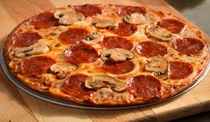 Restaurant operators interested in offering gluten-free items are more often highlighting naturally gluten-free options and making simple changes as opposed to developing new innovation, said Kathy Hayden, a food service analyst with Mintel International, Chicago.
Restaurant operators interested in offering gluten-free items are more often highlighting naturally gluten-free options and making simple changes as opposed to developing new innovation, said Kathy Hayden, a food service analyst with Mintel International, Chicago.“The best bet for restaurants is to point out items that are naturally gluten-free,” she said.
The number of gluten-free menu claims has risen dramatically in recent years. According to Mintel Menu Insights, there was a 275% increase in gluten-free menu item claims from 2009 to 2012. Gluten-free claims for pizza and hamburgers have increased especially dramatically as restaurants have worked to offer gluten-free crusts and buns. Salads, fondue and chicken breasts also have increased significantly in gluten-free claims.
Technomic, Chicago, has found gluten-free claims are the most prevalent at Top 500 and emerging full-service restaurants, according to a recent healthy eating trends report. The claims also represent the top health claims on emerging-chain limited-service menus. Limited-service pizza and sandwich chains along with full-service, varied-menu operators have been active in the development of gluten-free options since 2010, Technomic said.
“Take a look at your current menu; you may be surprised at how many items can easily be converted to gluten-free,” said Beckee Moreland, director of gluten-free industry initiatives at the National Foundation for Celiac Awareness. “By using gluten-free tamari instead of soy sauce, or using cornstarch to make a roux, you can open up the possibilities.”
Ms. Moreland said items such as fresh fruits, vegetables, meat and dairy are naturally gluten-free, and there are gluten-free alternatives for flour, pasta and bread, but operators should confirm with the manufacturer that the products have been tested or certified gluten-free.
While many simple changes are occurring, there is also some true innovation being developed. Domino’s Pizza, Ann Arbor, Mich., has launched a gluten-free crust, although it is not recommended for consumers requiring strict gluten avoidance.
“Unfortunately, our kitchen practices do not allow for a full gluten-free product intended for those with celiac disease, but we are pleased that the … people who suffer from gluten sensitivity now have an option,” said Chris Brandon, Domino’s spokesperson.
Mr. Brandon said training across Domino’s restaurants has been important. The company required training videos for assistant general managers and general managers to review, a brochure with frequently asked questions and facts are available for reference at all stores, key facts are required to be in view at every order-taking station, and the company communicates its disclaimer in many ways. Domino’s even requires on-line customers to acknowledge they have read the disclaimer before ordering the gluten-free crust.
“At this time, a gluten-free crust pizza is within our operational capabilities, responds to the needs of a choice consumer base and provides many of our customers – who weren’t able to prior – the ability to enjoy a Domino’s pizza,” Mr. Brandon said. “For those reasons alone, we are pleased it will continue to be a part of our menu.”
Subway, Milford, Conn., is currently testing gluten-free rolls and brownies in about 535 restaurants in several markets across the country. The products are pre-packaged. Mark Christiano, worldwide baking specialist for Subway, said the company is working to make sure a process is in place to ensure there is no cross-contamination during the making of the sandwich.
Ms. Moreland said restaurant operators need to assess the risks in their kitchen, and once they decide what they may safely offer, they need to clearly convey that message to customers. She said a dedicated kitchen space is always preferable, but there are ways to reduce risk in a shared kitchen, such as instituting procedures that recognize hot spots and prevent cross-contact. She said the best approach is to complete a gluten-free training program and implement the recommendations made in the training.
Ms. Hayden said pre-packaged items are always a good option in helping offer gluten-free alternatives, although there is still a risk for cross-contamination.
Overall, Ms. Hayden said while she doesn’t see the gluten-free market as a fad, she does believe it’s a trend that will level.
“If you can at least keep something on the menu that addresses these needs, then it’s worthwhile,” Ms. Hayden said. “But in terms of reformulating entire menus or even sections of menus, that might be unwarranted at this point. I think it’s a trend that will settle.”
Ms. Hayden and Mary Chapman, director of product innovation at Technomic, suggested the market is being driven by the same factors that are driving the market in retail — an increase in celiac diagnosis, increasing numbers of people with gluten intolerance, and a consumer perception the products are healthier.
Ms. Chapman said once additional medical research emerges suggesting the products aren’t necessarily healthier, there might be an additional leveling of the market.





